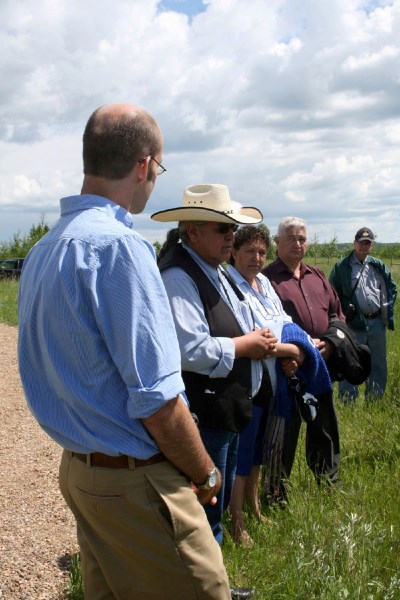A tale of starvation, anger and conflict unfolded in Frog Lake in 1885, but the site of what was once bloodshed is now hoped to be a site of cultural understanding and reconciliation.
Last Thursday, representatives from Alberta Culture came together with those interested in history and First Nations from Frog Lake and Onion Lake to mark the result of a five-year-long project – the unveiling of panels that tell the story of the Frog Lake Massacre.
“We wanted to properly honour the history of the events that took place here,” noted project manager Melissa Austin, with the historical resources management branch of Alberta Culture. Despite the site’s provincial and nationally-recognized significance, not many people are aware of what happened in Frog Lake at that time, she said.
Here, on what was once part of a settlement, there lie the archeological remains of privy holes, cellar depressions and trash pits, with the relics of eating implements, bottles and other things scattered around the bush. A graveyard and federal plaque, owned by Parks Canada and erected in 1924, honour the nine people killed in the massacre, but there is now a 340 metre path along which people can read panels, in French, English or Cree, about what unfolded on the fateful day of April 2, 1885.
Plains Cree, headed by Chief Big Bear, were staying with Woods Cree in the Frog Lake area, but didn’t have food, what with a dwindling buffalo population, and were slowly starving. Although Big Bear sought improved conditions for his people through peace and unity, the Indian Agent on the ground, Thomas Quinn, was unsympathetic to their needs.
When they heard about the Métis uprising in western Canada and the North-West Rebellion, it set something off in the starving people. Despite the reservations of their chief, a party of warriors captured Quinn and other prisoners and ordered them to move to an encampment. When Quinn refused, war chief Wandering Spirit shot him in the head, and in the ensuing panic, eight more white people, including two priests, were killed. The Plains Cree then burned the settlement to the ground.
After the massacre, eight First Nations people were hanged, the largest mass execution ever in Canada, while Big Bear was sent to prison for treason. The massacre, as it was called, became news across Canada and influenced Canadian policies and attitudes towards treaty-making with First Nations, said Alberta Culture’s Matthew Wangler, adding, “It’s a legacy that’s very much with us today.”
The accepted narrative simply became that a bunch of savages slaughtered innocent white people, said Wangler, but he hoped that the panels would reveal the complexity of the story.
Frog Lake elder Annie Stanley recalled her father-in-law was 17-years-old when the massacre happened. In fact, he tried to save one of the preachers, but couldn’t stop the killing at the settlement, and instead, was forced to run to the reserve, she said. “He had to go across the creek to warn the people of Frog Lake what was happening.”
Now, her grandchildren know nothing about that history, she said, a feeling echoed by Chief Wallace Fox of Onion Lake Cree Nation. “The real history was never taught to us when we were in schools,” he said. “It was not a massacre, people were forced into starvation.”
He hoped for better in the future in relations between the government and First Nations people. “It’s time government sits with us as equals. We are no less, we are no greater. We are all human beings.”
He also shared his hope that the site, located east of the Frog Lake town site towards Fishing Lake Métis Settlement, would draw people from various backgrounds to understand what unfolded in the past and what is happening in the present and that the site would “foster a mutual respect for our cultures.”



